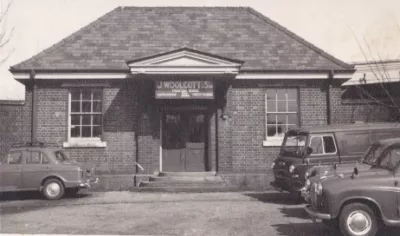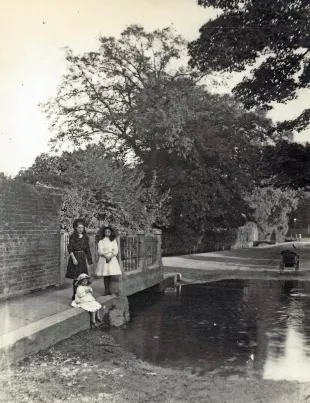The Other Rail Line to Rickmansworth.
Recollections of using the line, by Three Rivers Museum member Joan Schneider in about 2004.


The story of the line itself is here.
The LMS line between Rickmansworth and Watford closed in 1952, but from 1940 to 1945 I was, along with a number of other pupils, a regular traveller to and from Watford High Street Station on the way to Watford Grammar School for Girls (there was no Grammar School at Ricky). The half day return fare was I think 2 1/2 old pence, cheaper than a season ticket, so we queued at the booking office each morning. Once I was late and rushed onto the platform as the train began to move; the driver noticed and stopped for me to get on.

Each train (electric) consisted of three coaches. The front and back ones, Third Class, were laid out like a tube train, with seats facing each other across a central aisle, but the middle coach included a small First Class section, subdivided into compartments, with a corridor going through the middle. A few regular commuters travelled First Class, but their privacy was often invaded by us Grammar Grubs romping through.
Another amusement was to use the strap loops, intended for the convenience of standing passengers, as gymnastic apparatus, and sometimes a row of upturned girls would hang there, skirts stuffed into navy knickers, (or in summer blue cotton with a white chequered pattern). One particularly bold spirit, aged about 12, used to open one of the sliding exit doors and hang out of it, holding on to the brass handle on the outside of the train as we trundled through the countryside. Our fellow-passengers must have been remarkably tolerant, for they seldom complained and never told tales on us to the school authorities - a terrible retribution would have fallen on us if they had. Perhaps they were too frightened of the Watford St Trinian's, but I think our behaviour was trying rather than threatening.
At the end of the school day (4pm) the Rickmansworth girls were allowed out 10 minutes early to catch the 4.10pm train. Today a major road separates the school from the High Street Station but then it was just a few minutes walk up the street, through a smelly alley past the brown-tiled gents of the Crown Public House and a few yards down the High Street. At the Ricky end the walk was through the pleasantest part of the old town: the churchyard first. I remember the iron railings being removed for wartime "salvage", and the shiver up the spine it gave us to pass the tombs and graves, no longer protected by a fence. After passing the Feathers [Public House] I either continued on to the High Street to wait at the stop opposite the Swan [Hotel] [now the Post Office now stands on the site] for the 321 bus home to Money Hill Parade (we lived at 3 Elm Way), or turned off Bury Lane to walk alongside the Town Ditch which disappeared mysteriously under fences and slid over the Water Splash (although it is now more than 50 years since I left Ricky I still regard the covering in of the Water Splash as the most painful and senseless of all the many environmental crimes of the 1960s). The Smithy, with its distinctive smell of burning hoof, stood near the Water Splash, but the smith was not friendly and did not care for children watching him at work.


The route of the railway line followed the Colne Valley, passing very close to the place where the Three Rivers join. There were at least seven bridges carrying the line over various watercourses and it went under the Metropolitan Line near a small lake and "Murder Wood" (if I ever knew the reason for this name I have forgotten it). Then there was the asbestos works on the right and a branch line off on the left to [Dickinson's] papermill in Croxley Green, I think, and stacks of what I was told was "esparto grass" used in papermaking. The surroundings were rural until you reached the junction with the Watford - Croxley Green line and you were almost in Watford. It must have been here that the driver slowed as he passed a signal box and gave up the brass staff that entitled the train to travel on the single track line to Ricky.

Then under Wiggenhall Road and there was the school playing field on the left with the school building beyond. During "recess" and the dinner hour the wire-mesh fence which divided the school field from the railway was often lined with inverted girls - hand-stands were the thing.

The Battle of Britain coincided with my first term at Watford Grammar School and we had to have our gas masks with us, their cardboard boxes contained in a variety of home-made or commercially produced carrying cases. We were organised into groups of girls under the charge of a prefect. On one occasion the air raid sirens sounded after we left the LMS station and we were shepherded down into a public shelter near the Bury. We were not there very long before the "all clear" went and that was the only occasion during the whole of the war that I entered a public shelter, though through that September we spent many hours of our school days down in basement cloakrooms doing lessons or playing cat's cradle while air aid warnings were in force.
The last occasion on which I used the line to Rickmansworth was in about 1950, after moving north with my family. I was on my way to visit a friend who lived in Norfolk Road (her house was still lit by gas). For old time's sake I took the route via Watford High Street Station. As the train came in from the Junction there was the familiar cry "Rickmansworth train, Ricky only!", from the porter. I boarded with my suitcase. He could not believe that this was not a mistake and came over to ask where I wanted to go. He must have known every regular passenger for Ricky by sight. It is not surprising that the line closed two years later.
